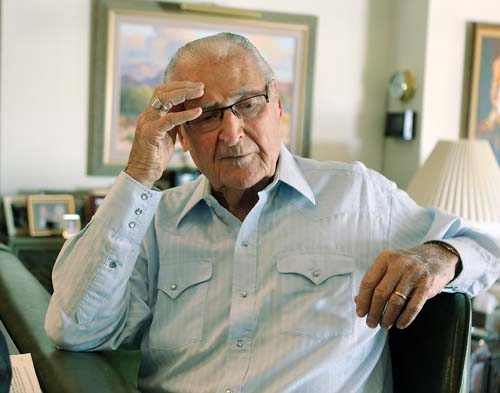Wartime memories still vivid for B-29 pilot
Leonard Carpi will put on his 9th Bomb Group cap today, the one he always wears on Veterans Day, the one that shows a gray B-29 Superfortress flying above the bill with the words, "Tinian Island 1945."
Still fit at 86 but not as agile as when he played football in the days of leather helmets, Carpi said he won't be in today's Veterans Day Parade when thousands line the streets and cheer for those who served in World War II and every war since.
But Carpi said he will be "around town," wearing that B-29 ball cap, and will think about the bullets he dodged and the crew mates who counted on him to bring them home safely on April 5, 1945.
"We were bombing the Mitsubishi aircraft engine factory and we were in the lead group," he said Tuesday about the mission over Nagoya, Japan. "Right at 'bombs away,' we got a direct hit in the No. 4 engine. Not just flak but the whole thing burst, and it knocked out the oil so we couldn't feather the engine.
"So it was like a big wall up there windmilling around. The first thing you do when you've got an engine on fire and you've got gasoline is you want to get away."
The 11-man crew prepared to bail out, but his gunner had seen another crew in a crippled B-29 bail out in front of them.
"The Japanese fighters were chewing them up in their parachutes. So we took our chances and dove for the coast because we had some submarines out there that would pick us up," recalled Carpi, a retired optometrist who moved to Las Vegas from Southern California with his wife, Betty, in 1954.
Fortunately, the fire snuffed out as the hulking Superfortress plunged through the air. When Carpi and commander Fritz Sheaffer leveled it out, they decided to try to ditch the aircraft in the ocean.
"As we were throwing out all the equipment that was loose, anything to lighten the airplane, one of the flak suits got caught in the bomb bay door. We couldn't close the door."
As they circled over a friendly submarine they managed to free up the doors. At the low altitude, one of the other engines that had been shot up suddenly kicked in.
"So we said, 'What the hell. Let's try getting it back to Iwo Jima,' which was about four or five hours away."
They flew "practically on top of the waves" until the island's runway came in view.
"There was another airplane that had crashed, so we had to land on the fighter strip right by Mount Suribachi. Because Iwo Jima was not secure yet, they were shooting at us," Carpi said.
Despite the hail of gunfire, "we made it in with no problem. But the fighter strip was so short that both of us had to jump on the brakes, and we just slid all the way down to the end."
It wasn't the first or the last time his bomber came back riddled with bullet holes.
Among his scariest missions was a fire-bomb raid that then-Maj. Gen. Curtis LeMay ordered at 5,000 feet over Tokyo.
"When we heard about this, we were all naturally upset," Carpi said. "What the hell were we doing at 5,000 feet, where the could practically throw rocks at us?"
As LeMay had predicted, the raid turned out to be a success. The planes dropped 1,665 tons of incendiary bombs, destroying more than 16 square miles of the city in the heart of Japan's war machine.
The raid destroyed 250,000 buildings and killed 100,000 civilians.
"Our job was not to kill people, but to stop them from doing their job of supporting the war. Every time we turned (over a target) I thought of those people in the bottom of Pearl Harbor in the Arizona. I thought of them every time," Carpi said, his voice cracking.
At 20, he became one of the corps' youngest pilots to command a B-29. As a pilot and co-pilot, he racked up 35 combat missions, many of those in the plane he commanded, dubbed Tokyo-KO.
Monsoon rains poured down on his first mission as commander taking off from Tinian. As he taxied into take-off position, the plane in front of him crashed into the ocean.
While he was holding his position the rain came down harder.
"I could hardly see my wing tips, and here I was a new airplane commander and 20 years old," he said.
"If those guys in the back knew how scared I was flying that thing at that time where I couldn't even see hardly what I was doing, they would have jumped out.
"But we made it."
Contact reporter Keith Rogers at krogers@review journal.com or 702-383-0308.
Veterans Day closures
PARADE SET FOR DOWNTOWN
The annual Veterans Day Parade will get under way at 10 a.m. today along Fourth Street from Hoover Avenue to Stewart Avenue in downtown Las Vegas.
Organizers expect a crowd of 40,000 to watch 120 entries with 5,000 participants marching and rolling through the downtown area.
In November 1919, President Woodrow Wilson proclaimed Nov. 11 as the first commemoration of what was called Armistice Day, primarily to honor World War I veterans on the anniversary of the armistice that ended the war in 1918 at the 11th hour of the 11th day of the 11th month.
An act of Congress on May 13, 1938, made Nov. 11 a legal holiday each year dedicated to world peace.
In 1954 after the Korean War, veterans service organizations persuaded Congress to amend the 1938 act by striking the word "Armistice" and inserting "Veterans" in its place to honor U.S. veterans of all wars.
LAS VEGAS REVIEW-JOURNAL



















